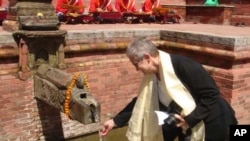Pangboche Monastery -- one of the oldest centers of Sherpa learning and culture in Nepal's Solu-Khumbu region – will be restored with a grant from the Ambassadors Fund for Cultural Preservation. The U.S. Embassy in Nepal announced August 18th that the Ambassadors Fund awarded a grant of $83,500 to the Mountain Institute to restore the monastery and its environs.
The Mountain Institute is an international non-profit organization dedicated to conservation, community development, and cultural preservation in the Andes, Appalachians, Himalayas and other mountain ranges of the world.
Located in a small Sherpa village in the Solu-Khumbu district, Pangboche Monastery was established in the 16th century by the Lama Sangwa Dorji, who accompanied early waves of Sherpa migrants from Tibet at that time. The Lama also established the nearby Tengboche monastery and was founder of Buddhist learning in the region. A chorten, or reliquary, near Pangboche monastery contains some his relics. As the highest permanent settlement on the road to Everest, Pangboche currently serves as a vital center for the surrounding populations, particularly during the observance of annual cultural festivals.
Over the past 9 years, the U.S. Government has committed approximately $1,340,000 to restore and preserve 10 cultural sites throughout Nepal. Projects previously supported by the Ambassadors Fund for Cultural Preservation include the restoration of Kal Bhairav and Kageshwor Temples in Kathmandu's Durbar Square, renovating ancient Buddhist chortens in upper Mustang, and continuing the restoration of Patan Durban Square in Lalitpur, including the Patan Royal Palace.
Established by the U.S. Congress in 2001 and administered by the U.S. Department of State, the Ambassadors Fund for Cultural Preservation annually provides direct grant support for the preservation of cultural sites, cultural objects and collections, and forms of traditional cultural expression in countries around the world selected through a highly-competitive process. Since its inception the Fund has demonstrated America's respect for the cultural heritage of other countries by supporting more than 500 cultural preservation projects in more than 100 countries.
The United States is committed to working with Nepal to help preserve and protect the cultural treasures of the Nepali people.
Preserving Nepal's Culture

The Pangboche Monastery, a center for Sherpa learning and culture built in the 16th century, will be restored.


















